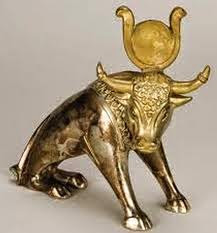Alice C. Linsley
In ancient Egypt, Saturn was called "Horus, Bull of the Sky." Mars, Jupiter, and Saturn were depicted with the falcon-head of Horus (Krupp 1979).
The Akkadian word for a powerful (Alpha) bull is gud. This may be the source of the word God. This would explain why in Iceland, þjór' (thor) means bull and also is the name of the High God of the Nordic pantheon before he was displaced by or renamed Odin.
The Akkadian word for bull is turu. The Danish word for bull is tyr. In Swedish bull is tjur. In Latin, bull is taurus. These share the TR root which suggests a connection to blood, purity, radiance, the Sun, copper, gold, and holiness.
The Proto-Dravidian word tor refers to blood. In Hausa, toro means clean, and in Tamil tiru means holy. There appears to be a relationship between tor and the Hebrew thr which means "to be pure." The people were made pure when the High Priest sacrificed the bull and made atonement with the blood of the sin offering (Ex. 30:1-10).
Clearly, the TR root is very old as it reflects the polysemic feature of the oldest known Indo-European lexicons and many of the words in those lexicons share roots with Ancient Akkadian, the oldest know Semitic language.
The terms for ritual purity in Sumerian, Akkadian, Biblical Hebrew, Hittite, and Ugaritic are related to the idea of radiance. (See The Semantics of Purity in the Ancient Near East, p. 5.) The ancient Nilotes associated purity with the radiance of the sun, the emblem of the High God Re. (Re means "Father" in ancient Egyptian.)
Ra's bull in the sky is symbolized by the Sun. In the Ancient Pyramid Texts (2400-2000 BC) the King addresses the celestial bull saying, "Hail to you, Bull of Re who has four horns, a horn of yours in the west, a horn of yours in the east, a horn of yours in the south, and a horn of yours in the north! Bend down this western horn of yours for me that I may pass."
The association of Horus and the rising sun is evident in the Horus name of some Nilotic rulers. The Horus name of Thutmose III was "Horus Mighty Bull, Arising in Thebes."
The rising sun represents resurrection, and the deceased king seeks passage to the place of immortality in the sky (duat), among the imperishable stars. He is recognized as a "pure Westerner" who has come from Nekhen, the oldest known site of Horite Hebrew worship.
According to the Pyramid Texts, Utterance 205, the Great Bull smites the enemies of Re. This is expressed in the Pyramid Texts, Utterance 388: "Horus has shattered (tbb, crushed) the mouth of the serpent with the sole of his foot." Those words are echoed in Genesis 3:1, the first messianic prophesy of the Bible.
The appointed bull calf of the Horite Hebrew would have looked like this.
The Great Bull is Horus the appointed bull calf who has reached mature strength. He is to pass to the heavens on the third day. "Oh Horus, this hour of the morning, of this third day is come, when thou surely passeth on to heaven, together with the stars, the imperishable stars." (Pyramid Texts, Utterance 667)
According to the Coffin Texts, Horus is "the great Falcon upon the ramparts of the house of him of the hidden name" and he says: "my wrath will be turned against the enemy of my father" and "I will put him beneath my feet." (Utterance 148)
This text is at least 800 years older than the Messianic reference of Psalm 110:1: The Lord says to my Lord: “Sit at My right hand until I make your enemies a footstool for your feet.”
The Bull is to be sacrificed so that the king may eat the foreleg and haunch in the sky (Utterance 413). By forbidding the consumption of the thigh tendon attached to the hip (Gen. 32:32) Judaism distances itself from the Horite Hebrew Faith.
By eating the sacrifice, the deceased king becomes one with the sacred bull. The king is urged to rise, to "gather his bones together, shake off your dust" and enter into immortality.
Related reading: Sky Bull Eaten to Gain Immortality; The Afro-Asiatic Conception of Purity; The Ra-Horus-Hathor Narrative; Abraham's Faith Lives in Christianity; Early Resurrection Texts




.jpg)









No comments:
Post a Comment